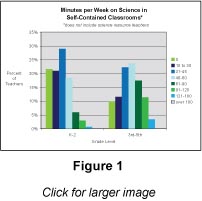
Teachers and districts report that a limited amount of time is spent on science education in Bay Area elementary schools.
Eighty percent (80%) of K–5th grade multiple-subject teachers who are responsible for teaching science in their classrooms reported spending 60 minutes or less per week on science, with 16% of teachers spending no time at all on science. Figure 1 displays related teacher survey  results by grade band in greater detail. Another way of looking at these data reveals that students receive an average of 60 minutes of science instruction per week. This estimate is considerably lower than the 125 minutes per week reported as a result of a national survey8 conducted in 2000.
results by grade band in greater detail. Another way of looking at these data reveals that students receive an average of 60 minutes of science instruction per week. This estimate is considerably lower than the 125 minutes per week reported as a result of a national survey8 conducted in 2000.
District office estimates were more optimistic, indicating that 50% of elementary school classrooms spend 60 minutes or less per week on science; these estimates include those districts with science resource teachers.
According to both teachers and district office personnel, about 80% of all elementary school students receive science instruction 3 times per week or fewer, with the majority of students receiving 2 days or fewer.
Echoing a recent national study,9 district representatives who responded to our survey and participated in interviews reported that a diminishing amount of time has been spent on science since the enactment of No Child Left Behind (NCLB). Those districts with schools in Program Improvement (PI) status, due to their prior language arts and mathematics test results, report little to no time for science at all. In a few exceptional circumstances (special programs, community priorities), individual schools go against that trend, focusing adequate time and attention on science instruction.
